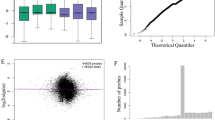Abstract
Tetrabromobisphenol A(TBBPA) is used as a brominated flame retardant and can easily release into environment. It has been detected in a variety of environmental media and even in food, making it a new pollutant that is potentially harmful to environment and human health. However, the toxicity and underlying mechanism of TBBPA remain to be explored. TBBPA is actively metabolized in the liver, so it is vital to study the hepatocellular toxicity of TBBPA. In this study, we treated hepatocellular carcinoma cells(HepG2) with TBBPA and searched the differentially expressed genes(DEGs) triggered by TBBPA exposure. RNA-seq analysis showed that the expression of genes, such as CLIC1 and GATSL1, were significantly down-regulated and PTENP1 was significantly up-regulated after TBBPA exposure, and these genes were involved in cell proliferation and metabolism. The down-regulated genes were enriched to peroxisome proliferator-activated receptor(PPAR) signaling pathway and up-regulated genes were enriched to Janus Kinase-signal transduces and activators of transcription(JAK-STAT) signaling pathway, which play a role in regulating cell growth. Overall, our transcriptome analysis obtained for TBBPA-treated HepG2 cells implies that TBBPA affects the cell proliferation and growth.

Similar content being viewed by others
References
Liu K., Li J., Yan S. J., Zhang W., Li Y. J., Han D., Chemosphere, 2016, 148, 8
Yann G., Dana L., Kathryn Z. G., Fatiha E. G., Veronique B., Lamia B. T., Heidi M., Kurt S., Lancet Oncol., 2016, 17, 419
Mohamed A. A., Environ. Int., 2016, 94, 235
Yang S. W., Wang S. R., Liu H. L., Yan Z. G., Environ. Sci. Pollut. Res., 2012, 19, 4090
Joana F., Melissa M., Elisa C., Environ. Pollut., 2021, 285, 117475
Linda S. B., Ake B., Environ. Health Perspect., 2010, 118, A514
Juliette L., Chemosphere, 2008, 73, 216
Ahmedin J., Freddie B., Melissa M. C., Jacques F., Elizabeth W., David F., CA Cancer J. Clin., 2011, 61, 69
Gu X. S., Manautou J. E., Expert Rev. Mol. Med., 2012, 14, e4
Kim U. J., Oh J. E., Environ. Pollut., 2014, 184, 193
Yu Y. J., Hao C. J., Xiang M. D., Tian J. L., Kuang H. X., Li Z. C., Sci. Total Environ., 2022, 832, 154847
Chi Q., Zhang W. X., Wang L., Huang J., Yuan M., Xiao H. M., Wang X., Chemosphere, 2019, 246, 1
Lyu L., Jin X. J., Li Z. Y., Liu S., Li Y., Su R. J., Su H. L., Ecotoxicol. Environ. Saf., 2020, 192, 110255
Jennifer J. T., Jan K., J. Angiogenes Res., 2010, 2, 23
Kwang S. S., Stuart H. Y., Curr. Pharm. Des., 2005, 11, 2753
Mark A. B., James R. G., Cell Motil. Cytoskeleton, 2003, 56, 159
Wei X. Y., Li J., Xie H. Y., Wang H. X., Wang J. G., Zhang X. Y., Zhuang R. Z., Lu D., Ling Q., Zhou L., Xu X., Zheng S. S., J. Gastroenterol Hepatol., 2014, 30, 208
Jacek L., Elzbieta Z., Dominik D., Jerzy W. L., NeuroToxicology, 2017, 63, 126
Linde D., Ellen W., Tom V. B., Peter V., Microbes Infect., 2009, 11, 1050
Tian T., Nan K. J., Guo H., Wang W. J., Ruan Z. P., Wang S. H., Liang X., Lu C. X., Oncol. Rep., 2010, 23, 1593
Chen C. L., Tseng Y. W., Wu J. C., Chen G. Y., Lin K. C., Hwang S. M., Hu Y. C., Biomaterials, 2015, 44, 71
Qian Y. Y., Li K., Liu Q. Y., Liu Z. S., Oncotarget, 2018, 8, 107859
Shi L. K., Karrar E., Wang X. G., J. Food Biochem., 2021, 45, 1
Tommaso M., Maria M., Andrea G., PPAR Res., 2016, 2016, 1
Kisseleva T., Bhattacharya S., Braunstein J., Schindler C. W., Gene, 2002, 285, 1
Acknowledgements
This work was supported by the National Natural Science Foundation of China (Nos.22234008, 21927807, 22021003).
We thank Dr. ZENG Jianming(University of Macau, China), all the members of his bioinformatics team and biotrainees, for generously sharing their experience and codes.
Author information
Authors and Affiliations
Corresponding author
Additional information
Conflicts of Interest
The authors declare no conflicts of interest.
Rights and permissions
About this article
Cite this article
Chang, H., Ding, Q. & Wang, H. Toxic Effects of Tetrabromobisphenol A on Human Hepatocellular Carcinoma Cells(HepG2) Evaluated Using RNA-Seq. Chem. Res. Chin. Univ. 39, 395–398 (2023). https://doi.org/10.1007/s40242-023-3069-2
Received:
Accepted:
Published:
Issue Date:
DOI: https://doi.org/10.1007/s40242-023-3069-2




